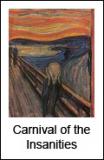
Rahal's Ride!
c Flying DebrisThis is one of my favorite race cars of early ‘70s, the
Porsche 917. 25 of these cars were built for the ’69 sports car season; they were very fast but notoriously untamed.
Porsche test driver
Hans Herman once said of the early 917 “Often I really believed that my next resting place would be in heaven.”1 The
’69 Le Mans 24 hour race was the closest
Le Mans ever. Yet the excitingly close finish was between a Porsche
908 driven by the 41 year old Herman and a Ford
GT40, driven by a 24 year old
Jacky Ickx; the vaunted 917 was not involved in the chase for the checkered flag. The Ford won after a final lap that featured several lead changes being reported back to the packed grandstands from the 8.365 mile course.
The next year, 1970 saw a
917L race at Le Mans with
this fantastic Martini Racing livery that inspired observers to dub it the “
hippie car” for its beautiful swirling paint job. The “hippie car” took second place in the rain soaked Le Mans of
1970 with
Gerard Larrousse and
Willibert Kauhsen at the wheel. The winning car was the
917K entered by
Porsche Salzburg, the firm owned by Louise Porsche Piech. Louise was the daughter of Porsche founder
Ferdinand Porsche, the older sister of then Porsche Chairman
Ferry Porsche and mother of
906 designer and later
Volkswagen Audi Group Chairman,
Ferdinand Piech. Her story is a wonderful one in itself. I once read an interview with her in which she said “I’ve only ever driven my family’s cars. First the cars of my father, then those of my brother, and now those of my son.”2
The fact that Louise had such a hot car in the 1970 race while customers
Martini Racing and
Team Gulf chased her car didn’t sit very well with the customers. On the other hand it was Louise who kept Porsche going both as the head of the firm and by moving supplies and funds through the various Allied Occupation Zones in the early post WWII period. During much of that time both her father and her brother were being held as economic war criminals in France due to the pre-war and war-time activities of Porsche, Ing. The engineering firm could count the
Volkswagen Beetle and the
King Tiger tank among their war related projects. An exasperating factor is the fact that Ferdinand Porsche, in his roll at the bizarrely named KdF (Kraft Durch Freude; the Nazi conglomerates’ name in German, translates as Strength Through Joy) had authority over the
Peugeot factories during the German occupation of France. Needless to say, Peugeot, a previously proud French firm, was not turning out smartly elegant French cars while under the thumb of
KdF. The area between where the Porsche family was living, Zell Am See and the firm’s base in Gmund was split by the post war authorities. German men had a much tougher time crossing between those zones than German women, giving Louise an advantage over the other early Porsche employees. It was an advantage that the young Porsche firm needed, for without that help it is likely that the firm would have lost many key employees to other opportunities.
The photo above shows the “hippy car” after being run on a Saturday afternoon by Bobby
Rahal in July of 2002. The shot was taken in the pits at
Road America in Elkhart Lake, WI. during the Brian Redman International Challenge (
BRIC). The BRIC has been renamed the
Kohler International Challenge with Brian Redman; KICBR doesn’t really work so it will likely still be called the BRIC. It is an annual vintage auto race held in July at the Kettle Moraine area race track, the longest road course in the US. The BRIC is also one of the largest vintage races in the country and is always a great time. The nearby towns of Elkhart Lake and Plymouth are nice Midwestern farming towns that have enough economic activity to still be described as thriving. They are the quintessential dairy towns of middle Wisconsin, a real throwback.
1 Porsche Excellence Was Expected by Karl Ludvigsen 1st Edition 1977 pg. 660 2nd Edition 2003 pg. 583
2
Excellence Magazine #143, Dec. 2005 pg. 82












